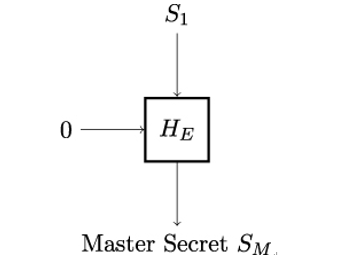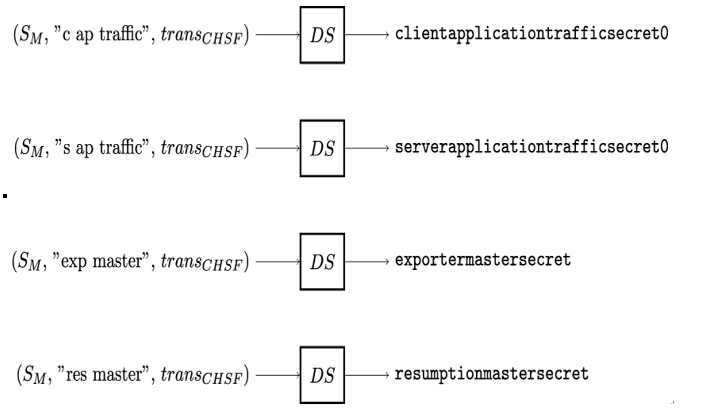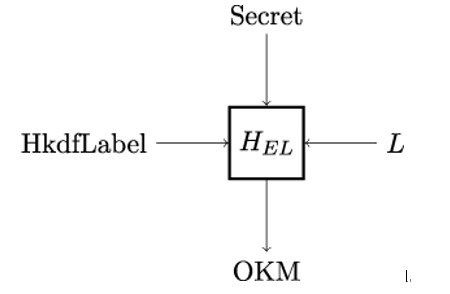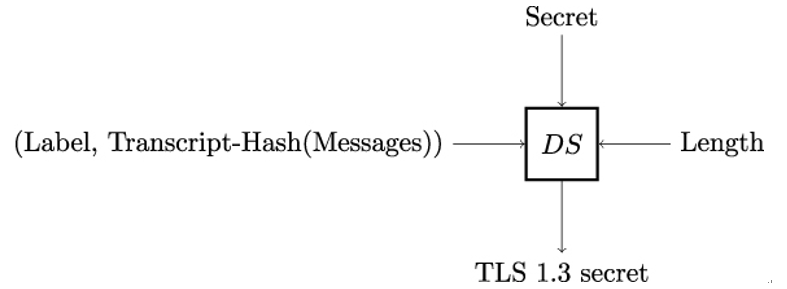Next, Alice and Bob compute the binder key kbind, client˙early˙traffic˙secret and early˙exporter˙master˙secret as shown in Figure 12.8. The binder key may be used to establish subsequent TLS sessions, and the early traffic secret and the exporter Master Secret are used to calculate the corresponding keys.

Figure 12.8: Derivation of TLS binder key, client early traffic secret and early exporter master secret
To prevent Alice and Bob from mixing up the binder keys, different labels are used for the derivation of the corresponding TLS secrets. For binder keys provisioned outside of TLS, the label ”ext binder” is used. For resumption keys provisioned as the resumption Master Secret of a previous handshake, the label ”res binder” is used.
If Alice and Bob choose to perform the TLS handshake based on a PSK, there are multiple possible values that the early secret SE can take. The actual value of SE depends on the PSK that Alice selects from those offered by Bob (using their identifiers).
As a result, Bob needs to compute the early secret for every PSK he offers to Alice. If Alice selects no PSK from those being offered by Bob, he needs to compute the early secret with a PSK being all zeros.
In the next step, illustrated in Figure 12.9, Alice and Bob compute the Handshake Secret SH and the second intermediate secret S1. The Handshake Secret is derived from the first intermediate secret S0 and the DHE or ECDHE key share that Alice and Bob exchange during the TLS handshake.

Figure 12.9: Derivation of the TLS handshake secret SH and the second derived secret S1
In the fourth step, Alice and Bob derive the client˙handshake˙traffic˙secret and server˙handshake˙traffic˙secret secrets needed to compute the corresponding handshake traffic keys. This is shown in Figure 12.10.
Note how – in addition to using the handshake secret SH itself – the handshake traffic secrets are derived using not only the ”c hs traffic” and c—”s hs traffic”— labels but also the transcript transCHSH of all TLS handshakes starting with ClientHello up until and including the ServerHello message.

Figure 12.10: Derivation of TLS handshake traffic secrets
Next, as shown in Figure 12.11, Alice and Bob derive the master secret SM. This secret will be used for the calculation of the application traffic keys for protecting the bulk application data Alice and Bob want to transmit over the secure TLS channel.

Figure 12.11: Derivation of the TLS master secret
While the early secret, handshake secret, and master secret (as well as the two intermediate derived secrets) can be viewed as raw entropy without any context, traffic secrets and exporter secrets include the TLS handshake context and, as a result, can be used to derive cryptographic keys without any additional context information.
Moreover, multiple invocations of the Derive-Secret function DS take the same TLS secret as input but return different outputs because they take different messages as additional input argument.
Finally, the master secret SM, the corresponding labels and the TLS handshake transcript transCHSF are used to derive the first application traffic secrets, the exporter master secret and the resumption master secret (see Figure 12.12). Transcript transCHSF includes all handshake messages starting from ClientHello up until including the Alice’s Finished message.

Figure 12.12: Derivation of the TLS application traffic secrets, exporter master secret and resumption master secret
This step concludes the derivation of TLS secrets from the keying material. However, the secrets may be updated without having to exchange new key material.


